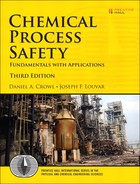Contents
1-3 Accident and Loss Statistics
1-6 The Nature of the Accident Process
1-8 Seven Significant Disasters
2-1 How Toxicants Enter Biological Organisms
2-2 How Toxicants Are Eliminated from Biological Organisms
2-3 Effects of Toxicants on Biological Organisms
2-6 Models for Dose and Response Curves
2-9 National Fire Protection Association (NFPA) Diamond
OSHA: Process Safety Management
DHS: Chemical Facility Anti-Terrorism Standards (CFATS)
3-2 Industrial Hygiene: Anticipation and Identification
3-3 Industrial Hygiene: Evaluation
Evaluating Exposures to Volatile Toxicants by Monitoring
Evaluating Worker Exposures to Dusts
Evaluating Worker Exposures to Noise
Estimating Worker Exposures to Toxic Vapors
3-4 Industrial Hygiene: Control
4-1 Introduction to Source Models
4-2 Flow of Liquid through a Hole
4-3 Flow of Liquid through a Hole in a Tank
4-4 Flow of Liquids through Pipes
4-5 Flow of Gases or Vapors through Holes
4-6 Flow of Gases or Vapors through Pipes
4-8 Liquid Pool Evaporation or Boiling
4-9 Realistic and Worst-Case Releases
5 Toxic Release and Dispersion Models
5-1 Parameters Affecting Dispersion
5-2 Neutrally Buoyant Dispersion Models
Case 1: Steady-State Continuous Point Release with No Wind
Case 3: Non-Steady-State Continuous Point Release with No Wind
Case 4: Steady-State Continuous Point Source Release with Wind
Case 5: Puff with No Wind and Eddy Diffusivity Is a Function of Direction
Case 8: Puff with No Wind and with Source on Ground
Case 9: Steady-State Plume with Source on Ground
Case 10: Continuous Steady-State Source with Source at Height Hr above the Ground
Limitations to Pasquill-Gifford Dispersion Modeling
5-4 Dense Gas Transition to Neutrally Buoyant Gas
Continuous Release Downwind Concentration
Instantaneous Release Transition
Instantaneous Release Downwind Composition
5-6 Effect of Release Momentum and Buoyancy
6-2 Distinction between Fires and Explosions
6-4 Flammability Characteristics of Liquids and Vapors
Flammability Limit Dependence on Temperature
Flammability Limit Dependence on Pressure
Estimating Flammability Limits
6-5 Limiting Oxygen Concentration and Inerting
Blast Damage Resulting from Overpressure
Energy of Mechanical Explosions
Boiling-Liquid Expanding-Vapor Explosions
7 Concepts to Prevent Fires and Explosions
Combined Pressure-Vacuum Purging
Vacuum and Pressure Purging with Impure Nitrogen
Advantages and Disadvantages of the Various Pressure and Vacuum Inerting Procedures
Using the Flammability Diagram To Avoid Flammable Atmospheres
Energy from Electrostatic Discharges
Energy of Electrostatic Ignition Sources
7-3 Controlling Static Electricity
General Design Methods To Prevent Electrostatic Ignitions
Increasing Conductivity with Additives
Handling Solids without Flammable Vapors
Handling Solids with Flammable Vapors
7-4 Explosion-Proof Equipment and Instruments
Area and Material Classification
7-7 Miscellaneous Concepts for Preventing Fires and Explosions
8-2 Commitment, Awareness, and Identification of Reactive Chemical Hazards
8-3 Characterization of Reactive Chemical Hazards Using Calorimeters
Introduction to Reactive Hazards Calorimetry
Theoretical Analysis of Calorimeter Data
Estimation of Parameters from Calorimeter Data
Adjusting the Data for the Heat Capacity of the Sample Vessel
Heat of Reaction Data from Calorimeter Data
Using Pressure Data from the Calorimeter
Application of Calorimeter Data
8-4 Controlling Reactive Hazards
9-4 Relief Types and Characteristics
Spring-Operated and Rupture Discs
Advantages and Disadvantages of Various Reliefs
10-1 Conventional Spring-Operated Reliefs in Liquid Service
10-2 Conventional Spring-Operated Reliefs in Vapor or Gas Service
10-3 Rupture Disc Reliefs in Liquid Service
10-4 Rupture Disc Reliefs in Vapor or Gas Service
10-5 Two-Phase Flow during Runaway Reaction Relief
10-6 Pilot-Operated and Bucking-Pin Reliefs
10-7 Deflagration Venting for Dust and Vapor Explosions
Vents for Low-Pressure Structures
Vents for High-Pressure Structures
10-8 Venting for Fires External to Process Vessels
10-9 Reliefs for Thermal Expansion of Process Fluids
11-1 Process Hazards Checklists
11-3 Hazards and Operability Studies
12-1 Review of Probability Theory
Interactions between Process Units
Revealed and Unrevealed Failures
Determining the Minimal Cut Sets
Quantitative Calculations Using the Fault Tree
Advantages and Disadvantages of Fault Trees
Relationship between Fault Trees and Event Trees
13 Safety Procedures and Designs
13-6 Procedures—Safety Reviews and Accident Investigations
13-7 Designs for Process Safety
Controls—Double Block and Bleed
Controls—Safeguards or Redundancy
Controls—Explosion Suppression
13-8 Miscellaneous Designs for Fires and Explosions
13-9 Designs for Runaway Reactions
13-10 Designs for Handling Dusts
Designs for Preventing Dust Explosions
Management Practices for Preventing Dust Explosions
Conductor in a Solids Storage Bin
Lessons Learned Concerning Static Electricity
Nitrobenzene Sulfonic Acid Decomposition
Lessons Learned Concerning Chemical Reactivity
Second Ethylene Oxide Explosion
Lessons Learned Concerning Designs
Phenol-Formaldehyde Runaway Reaction
Conditions and Secondary Reaction Cause Explosion
Lessons Learned Concerning Procedures
Training Regarding the Use of Standards
Lessons Learned Concerning Training
B Flammability Data for Selected Hydrocarbons
C Detailed Equations for Flammability Diagrams
Equations Useful for Gas Mixtures
Equations Useful for Placing Vessels into and out of Service
D Formal Safety Review Report for Example 10-4
E Saturation Vapor Pressure Data
F Special Types of Reactive Chemicals
G Hazardous Chemicals Data for a Variety of Chemical Substances
